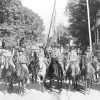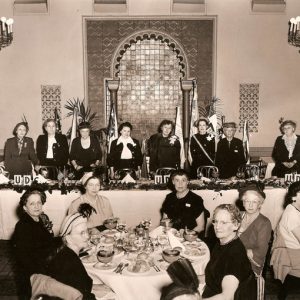calsfoundation@cals.org
United Daughters of the Confederacy
The first United Daughters of the Confederacy (UDC) chapter in Arkansas—and the second west of the Mississippi River—was Pat Cleburne Chapter 31, chartered on March 7, 1896, in Hope (Hempstead County). As with all Arkansas chapters, the objectives remain the same: historical, educational, benevolent, memorial, and patriotic. Mrs. C. A. Forney was the chapter’s first president. On January 21, 1952, the Arkansas UDC was incorporated as a non-profit organization. By 2020, Arkansas had twenty-two chapters.
The United Daughters of the Confederacy was the outgrowth of consolidating benevolent organizations and auxiliaries of United Confederate Veterans Camps, which were formed after the Civil War. On September 10, 1894, Anna Davenport Raines of Georgia and Caroline Meriwether Goodlet of Tennessee met in Nashville, Tennessee, to draw together these groups under the name the National Association of the Daughters of the Confederacy, with Goodlet as president. At a second meeting in 1895, the name was changed to the United Daughters of the Confederacy, and Mrs. John C. Brown became the first president-general of the modern organization.
An ongoing activity of the organization is the placing of monuments at historic sites, such as Arlington National Cemetery in Washington DC and the site of the Battle of Shiloh in Tennessee. The 1913 Jefferson Davis Highway Project was another major effort. It mapped a series of roads that linked Civil War sites from Washington DC to San Diego, California. After the states involved designated which roads were to be used, the United Daughters of the Confederacy began placing markers and their state trees and beautifying the route.
In addition to funding the placing of monuments in Arkansas (such as the Conway Confederate Monument on the grounds of the Faulkner County Courthouse in Conway, erected by the Robert E. Lee Chapter of the UDC in 1925), the Arkansas UDC became active in restoring monuments and signs erected in the past. During the latter part of the twentieth century, the Arkansas UDC restored the Little Rock (Pulaski County) Confederate Veterans Home sign, the Capital [Capitol] Guards Monument at MacArthur Museum, and the Arkadelphia Confederate Monument.
To join the United Daughters of the Confederacy, women must prove blood relationship to someone who served the Confederacy in an official capacity. It requires records such as birth or death certificates, marriage licenses, or census records that lead back to the ancestor.
The organization continues its mission of memorializing and celebrating the Confederate cause. However, in the twenty-first century, many Americans have called this purpose into question and, instead, see the UDC as promoting the Lost Cause myth at the expense of a more full account of the past, through its censorship of public school textbooks in the early and mid-twentieth century and through its sponsorship of Confederate monuments. As part of this, some have advocated for the removal of Confederate monuments from public land.
For additional information:
Janney, Caroline E. Burying the Dead but Not the Past: Ladies’ Memorial Associations & the Lost Cause. Chapel Hill: University of North Carolina Press, 2008.
Logan, Charles R. “Something So Dim It Must Be Holy”: Civil War Commemorative Sculpture in Arkansas, 1886–1934. Little Rock: Arkansas Historic Preservation Program, 1997. Online at https://www.arkansasheritage.com/arkansas-preservation/programs/publications (accessed April 18, 2024).
Moneyhon, Carl H. “Conflicting Civil War Historical Memory and Cultural Divides in Arkansas.” In Competing Memories: The Legacy of Arkansas’s Civil War, edited by Mark K. Christ. Little Rock: Butler Center Books, 2016.
Poppenheim, Mary B. The History of the United Daughters of the Confederacy 1894–1955. Raleigh, NC: Edwards & Broughton Printing Co., 1956.
United Daughters of the Confederacy, Mildred Lee Chapter No. 98, Records and Memorabilia, 1897–1990. Special Collections. University of Arkansas Libraries, Fayetteville, Arkansas.
Wanda Dean
United Daughters of the Confederacy
 Civil War Veterans' Reunions
Civil War Veterans' Reunions Confederate Mothers Memorial Park
Confederate Mothers Memorial Park Women
Women UDC Banquet
UDC Banquet 




Comments
No comments on this entry yet.